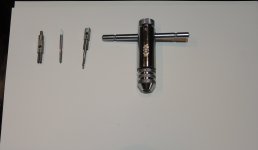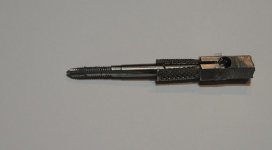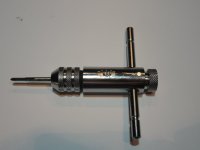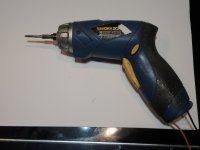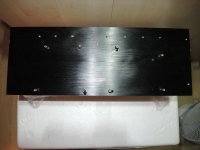Guys
As you know, sometimes there is s a need to threading, to fix a threaded bolt or whatever it might be.
If there is only 1, 2, 3, 4 or may 5 holes to thread you have to make, then most of us with some mechanical background would do this easy.
But as soon there are more threadings needed, say 20 or more. it will become very time consuming.
Now it happens that these day I need again tread some aluminium heatsink to hold 8 - T0264 Transistors, and also a large PCB with the size of 300x140 mm with a lot of component soldered to it.. So there are 8 Transistors that means 8 holes 8 times threading, and then also the stands for to hold the PCB fitted to the heat sink another 8. this makes 16 holes have to be drilled and 16 holes have to be threaded.
Take for one on hole a minimum time of 2.5 minutes to drill and to thread,
* any mechanic knows that this will not be enough time. * so then we have
16 x 2.5 minutes = 40 minutes, now we have two sides, left and rigth, so time doubles.. Again that would be fast, but I think 5 minutes for ome hole is average, so two pieces would take up 2.6 hours or 160 minutes. A lot of time..
This can be done faster. Go to a mechanical shop and have them done that.
You will need to draw them a layout, where the holes have to be. then may you have to wait because the shop has other customers which were first. And finally you have to pay them.
Do it by youself, get a Threading machine, for several hundred or even more Dollars. Or take this example and I can assure you that you will make one hole drilling and also threading under 2 minutes, neat and clean and of high quality.
There of course you will need a drilling machine, hand or standalone, and if possible brand new drills. HSS or better, make sure that the drill Cut Angle on top of the drill is correct for the material you are going to drill. that way you will get best results..
Till now no problem, anyone can drill a hole, but now threading, this is a thing for itself..
As threading will need forward and backward turning and also threading must be done on not to high speed most will use the manual way. Having a tool like to see in the picture..
But now there is the option ot have a threading machine made DIY, which works perfect on aluminum thin Stainless Steel plates and also copper.
I made a VIDEO, just to show that this is real inexpensive and fast and can be done almost by everyone who has a hand for DIY..
The Tool I use is this small hand drill, battery driven, to drill or to fix screws or bolts; I just modified and Steel bolt removed from MAC PRO to hold the Threadingdrill. Insert into the Hand drill and there we go.!
The rest you will understand if you look at the picture. Of course you will need some Cutting solution to drill holes or threading, but also this is inexpensive.. Lenox is the Brand Name I use, not to advertise this here, but it's rather cheap and good quality. This Heat sink time to drill and threading was less than 20 minutes. The thread are good to screw in aans out bolt at least a 100 times without losing the grip of the Bolt. So migth the one or other can make use of this.
Regards
Chris Hess
As you know, sometimes there is s a need to threading, to fix a threaded bolt or whatever it might be.
If there is only 1, 2, 3, 4 or may 5 holes to thread you have to make, then most of us with some mechanical background would do this easy.
But as soon there are more threadings needed, say 20 or more. it will become very time consuming.
Now it happens that these day I need again tread some aluminium heatsink to hold 8 - T0264 Transistors, and also a large PCB with the size of 300x140 mm with a lot of component soldered to it.. So there are 8 Transistors that means 8 holes 8 times threading, and then also the stands for to hold the PCB fitted to the heat sink another 8. this makes 16 holes have to be drilled and 16 holes have to be threaded.
Take for one on hole a minimum time of 2.5 minutes to drill and to thread,
* any mechanic knows that this will not be enough time. * so then we have
16 x 2.5 minutes = 40 minutes, now we have two sides, left and rigth, so time doubles.. Again that would be fast, but I think 5 minutes for ome hole is average, so two pieces would take up 2.6 hours or 160 minutes. A lot of time..
This can be done faster. Go to a mechanical shop and have them done that.
You will need to draw them a layout, where the holes have to be. then may you have to wait because the shop has other customers which were first. And finally you have to pay them.
Do it by youself, get a Threading machine, for several hundred or even more Dollars. Or take this example and I can assure you that you will make one hole drilling and also threading under 2 minutes, neat and clean and of high quality.
There of course you will need a drilling machine, hand or standalone, and if possible brand new drills. HSS or better, make sure that the drill Cut Angle on top of the drill is correct for the material you are going to drill. that way you will get best results..
Till now no problem, anyone can drill a hole, but now threading, this is a thing for itself..
As threading will need forward and backward turning and also threading must be done on not to high speed most will use the manual way. Having a tool like to see in the picture..
But now there is the option ot have a threading machine made DIY, which works perfect on aluminum thin Stainless Steel plates and also copper.
I made a VIDEO, just to show that this is real inexpensive and fast and can be done almost by everyone who has a hand for DIY..
The Tool I use is this small hand drill, battery driven, to drill or to fix screws or bolts; I just modified and Steel bolt removed from MAC PRO to hold the Threadingdrill. Insert into the Hand drill and there we go.!
The rest you will understand if you look at the picture. Of course you will need some Cutting solution to drill holes or threading, but also this is inexpensive.. Lenox is the Brand Name I use, not to advertise this here, but it's rather cheap and good quality. This Heat sink time to drill and threading was less than 20 minutes. The thread are good to screw in aans out bolt at least a 100 times without losing the grip of the Bolt. So migth the one or other can make use of this.
Regards
Chris Hess
Attachments
Last edited:
I watched the video.
I'd be worried about breaking the tap for smaller size threads, like a 4-40 (which I guess is about a M3x .5 size.
I didn't have sound on, so not sure what size you were making. They looked like they would bigger then M3.
It does look much easier than hand tapping. I am used to tapping a little ways in, then backing out and cleaning, then doing some more.
Do the threads come out OK with this method?
Randy
I'd be worried about breaking the tap for smaller size threads, like a 4-40 (which I guess is about a M3x .5 size.
I didn't have sound on, so not sure what size you were making. They looked like they would bigger then M3.
It does look much easier than hand tapping. I am used to tapping a little ways in, then backing out and cleaning, then doing some more.
Do the threads come out OK with this method?
Randy
Till now not one.. and I made already about with this at least over 100..You'll be breaking a lot of taps like that.
Do you think all the taps which are made in anything you buy, are made by hand.
Far away, hand made tabs are stone age..Sorry, but this is the truth..
May break the drill but shure not broken tabs..
Thanks anyway for the input..
If you do it by hand you can feel how much twisting pressure there is on the tap.
I know you can buy combination drill/taps for larger holes.
I guess it depends on hole size vs tap size.
A tight fit does need reversing, a loose fit not so much.
Trying to get a broken tap out of a heatsink is a pig of a job.
I use plenty of WD40 too.
I know you can buy combination drill/taps for larger holes.
I guess it depends on hole size vs tap size.
A tight fit does need reversing, a loose fit not so much.
Trying to get a broken tap out of a heatsink is a pig of a job.
I use plenty of WD40 too.
3 mm..I watched the video.
I'd be worried about breaking the tap for smaller size threads, like a 4-40 (which I guess is about a M3x .5 size.
I didn't have sound on, so not sure what size you were making. They looked like they would bigger then M3.
It does look much easier than hand tapping. I am used to tapping a little ways in, then backing out and cleaning, then doing some more.
Do the threads come out OK with this method?
Randy
I use this only for 3 -5 mm because the TABS ARE BETTER Than by hand..
There is no pressure needed. and if you look good then you see the drill going straight down.. less shaking than by hand, and about the time it's 10 to 1
It's just a thought, everybody everyone is old enough here to decide for himself what can be done and what not.. it was just an IDEA.,,
Anyway I will try to make some nice close up pics..
and try to show the tabs..tomorrow.. I've got more then 200 Tabs to do in the coming weeks.. I will count the bad ones.. till now, not one.
BTW charge the battery one time it can be used to make 20 TABS..
I have a large standing Drill, it might weight 50G`KS, and I used it without power made the turns by hand, then also same size, tabs do not differ.
In Switzerland the latest in Tab drilling is PRESSING or ROLLING the tabs No more drilling.. but this machine cost a fortune, and would also need a CNC as well I had to hear..
Anyway thanks for your input..
That small battery driven Drill has a clutch, you can adjust to slip when to much force is in use.. this is about the same as the twisting by hand.If you do it by hand you can feel how much twisting pressure there is on the tap.
Again one more time for you, this Drill has forward and reverse, instant switchable. better that anyone can do by hand, because the operator need only to hold it straight that's allA tight fit does need reversing, a loose fit not so much.
These heat sink I tap here, the piece cost about 75 USD, I can assure you that I take real care not to have broken tabs in there..Trying to get a broken tap out of a heat sink is a pig of a job.
I use plenty of WD40 too.
it is like everything else in the world Training makes the champ..
One can create broken tabs by hand more you think it could be..
In my other place I have access to a big standing Treading machine..
But this place is 65KM away from home, and the Amps I build here at home, in the evening, large tabs 6mm and up I do with that professional machine..
But for small ones like 3mm -5mm I use this here.. saves a lot of time..
Yes just beautiful tight better that I can do by hand..Do the threads come out OK with this method?
Randy
I also have access to professional machines, but these I use only for larger TABS because that small drill hasn't enough torque to make larger Tabs than 5mm..
this runs on 3.7 Volts only so think about that, It was a try sometimes ago but the piece which holds the TAB drill didn't fit that good.. now, I have found a piece which holds the drill tight, and therefor it's peanuts..
Of course Aluminum isn't Aluminum depends where it comes from, and it takes some testing and training but as soon after a few tab, it's a easy as placing the butter on the bread in the morning.
It's different for copper because Copper need more torque there also it is important that moving forward and reverse all two three Seconds to get the copper out of the way, Otherwise it's overload the drill.
Thanks for the input.. Getting a close up of the TAB tomorrow..
Keep an eye out for spiral point taps, also known as gun taps or chip-driver taps. They are really only usable for through tapping, but they are designed for power tapping. Often you can even find ones with flats on the shank so they’ll chuck firmly into a drill. They have a bull nosed end with spiral chip flutes so that they remove chips easier and flow lubricant better. The thread cutting flutes are also cut shallower so there is more shank material and therefore more strength. Really just watch your drill alignment and you should be fine, especially with aluminum and copper, both are quite soft.
If you really want to get heavy into power tapping you could look into a tapping head like a Tapmatic self reversing, but they aren’t a cheap solution!
If you really want to get heavy into power tapping you could look into a tapping head like a Tapmatic self reversing, but they aren’t a cheap solution!
I think he is using machine taps, not hand taps.
3 mm Carbon steel taps are about $ 1 here for three, and a coated no brand HSS will be about $2 each...hand taps, not machine taps.
I have had taps done in plastic with a bench drill, simply used the reverse / forward switch.
And he got away with it because it was soft material, this method will not work on steel.
Nice hack, but only for soft material.
For larger holes, and so on, a tapping attachment with a torque sensing mechanism is best.
Or in large numbers of holes, simply drill a larger hole, and stick nuts with epoxy, or use sheet metal nuts.
3 mm Carbon steel taps are about $ 1 here for three, and a coated no brand HSS will be about $2 each...hand taps, not machine taps.
I have had taps done in plastic with a bench drill, simply used the reverse / forward switch.
And he got away with it because it was soft material, this method will not work on steel.
Nice hack, but only for soft material.
For larger holes, and so on, a tapping attachment with a torque sensing mechanism is best.
Or in large numbers of holes, simply drill a larger hole, and stick nuts with epoxy, or use sheet metal nuts.
I’ve done and seen done some questionable hand power tapping in steelAnd he got away with it because it was soft material, this method will not work on steel.
This is all toy work. Go to your nearest car maker. The 20-40 headbolt holes are drilled and tapped in the engine block in less than a minute; how else could they make cars so fast? Today in alloy but in olden days in cast iron.
Apparently even Jam Handy never filmed a block-tapper, but here's a similar operation:
30 SPINDLE DRILL TAP SPM FOR LED FIXTURES - YouTube
Remember that head-bolts will be 8 or 10mm, not these toothpick screws.
Apparently even Jam Handy never filmed a block-tapper, but here's a similar operation:
30 SPINDLE DRILL TAP SPM FOR LED FIXTURES - YouTube
Remember that head-bolts will be 8 or 10mm, not these toothpick screws.
In my DIY career, I have tapped 4-40 (M3X5 small) and 6-32 (M3.5x6 medium small), hmmm... estimate.... say over 300 of them by hand, maybe over 250 of these in aluminum heat sinks. Broke about 5 taps and have 2 lodged in the heat sink never to come out again.
Hand tapping is not as great as people say, it takes time and practice to get it right, and the taps wobble quite a bit, and of course its a huge PITA. And its time consuming.
Not only that but the hand tap screw handles have a cavity to hold the tap. For small taps like 4-40 the cavity is sometimes too large even at its smallest dimension to securely hold the tap end. I have 3 of these that are barely useful for the small taps that sat on the shelf next to them in the store.
I think the reason the method shown works so well is that he is using a small battery powered drill, I would use a small portable screwdriver. I have a Black & Decker in mind, which is sort of weak. Again the reason it works **I think** is that this is not a power drill, its so weak that it provides just enough force to move the tap down and out of the hole without breaking the tap, especially if you get the clutch setting correct.
The question I have is how to do get the tap into the drill with a secure fit? Mine don't even fit the hand taps anymore?
I think the video is great, for those willing to try something new and not stuck in the past of manual hand tapping. Heck, try it on some scrap and see what happens rather than criticize the idea. I always thought there must be a better way. But most of us seeing this simply cannot believe it, how can it be so easy? So we stick to the old ways.
I watched the video and immediately wanted hours of my life back!
Edit- I also think it would work in steel- say the bottom plate of a preamp, tapping a thin piece of steel is sometimes easier than delving an inch into a heatsink.
Hand tapping is not as great as people say, it takes time and practice to get it right, and the taps wobble quite a bit, and of course its a huge PITA. And its time consuming.
Not only that but the hand tap screw handles have a cavity to hold the tap. For small taps like 4-40 the cavity is sometimes too large even at its smallest dimension to securely hold the tap end. I have 3 of these that are barely useful for the small taps that sat on the shelf next to them in the store.
I think the reason the method shown works so well is that he is using a small battery powered drill, I would use a small portable screwdriver. I have a Black & Decker in mind, which is sort of weak. Again the reason it works **I think** is that this is not a power drill, its so weak that it provides just enough force to move the tap down and out of the hole without breaking the tap, especially if you get the clutch setting correct.
The question I have is how to do get the tap into the drill with a secure fit? Mine don't even fit the hand taps anymore?
I think the video is great, for those willing to try something new and not stuck in the past of manual hand tapping. Heck, try it on some scrap and see what happens rather than criticize the idea. I always thought there must be a better way. But most of us seeing this simply cannot believe it, how can it be so easy? So we stick to the old ways.
I watched the video and immediately wanted hours of my life back!
Edit- I also think it would work in steel- say the bottom plate of a preamp, tapping a thin piece of steel is sometimes easier than delving an inch into a heatsink.
Last edited:
Ah! Here is River Rouge Ford plant making Flathead V-8s. I've set the time to the end of the cylinder boring, just before they drill and tap ALL the headbolt holes. In about 12 seconds.
The Ford Rouge Plant 1941 - YouTube
BTW: this machinery (or sisters) was also used to make the 289 series V-8. Which explains only some of the oddities of the smallblock.
The Ford Rouge Plant 1941 - YouTube
BTW: this machinery (or sisters) was also used to make the 289 series V-8. Which explains only some of the oddities of the smallblock.
Last edited:
- Home
- Design & Build
- Construction Tips
- Threading the easy way, Cheap Fast and excellent Quality
